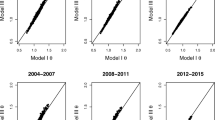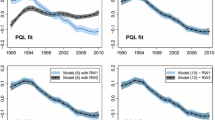Abstract
Objectives
This study aimed to review the types and applications of fully Bayesian (FB) spatial–temporal models and covariates used to study cancer incidence and mortality.
Methods
This systematic review searched articles published within Medline, Embase, Web-of-Science and Google Scholar between 2014 and 2018.
Results
A total of 38 studies were included in our study. All studies applied Bayesian spatial–temporal models to explore spatial patterns over time, and over half assessed the association with risk factors. Studies used different modelling approaches and prior distributions for spatial, temporal and spatial–temporal interaction effects depending on the nature of data, outcomes and applications. The most common Bayesian spatial–temporal model was a generalized linear mixed model. These models adjusted for covariates at the patient, area or temporal level, and through standardization.
Conclusions
Few studies (4) modelled patient-level clinical characteristics (11%), and the applications of an FB approach in the forecasting of spatial–temporally aligned cancer data were limited. This review highlighted the need for Bayesian spatial-temporal models to incorporate patient-level prognostic characteristics through the multi-level framework and forecast future cancer incidence and outcomes for cancer prevention and control strategies.

Similar content being viewed by others
Abbreviations
- PRISMA:
-
Preferred reporting items for systematic review and meta-analysis
- PQL:
-
Penalized quasi-likelihood
- EB:
-
Empirical Bayes
- FB:
-
Fully Bayesian
- MCMC:
-
Markov chain Monte Carlo
- INLA:
-
Integrated nested Laplace approximations
- IQR:
-
Interquartile range
- GLMM:
-
Generalized linear mixed models
- CAR:
-
Conditional autoregressive
- BYM:
-
Besag, York and Mollie
- APC:
-
Age–period cohort
- AFT:
-
Accelerated failure time
- ANOVA:
-
Analysis of variance
- SLA:
-
Second-level area
- ESM:
-
Electronic supplementary material
References
Adin A, Martínez-Beneito M, Botella-Rocamora P et al (2017) Smoothing and high risk areas detection in space–time disease mapping: a comparison of P-splines, autoregressive, and moving average models. Stoch Env Res Risk Assess 31:403–415
Austin PC, Brunner LJ, Hux Md Sm JE (2002) Bayeswatch: an overview of Bayesian statistics. J Eval Clin Pract 8:277–286
Banerjee S, Dey DK (2005) Semiparametric proportional odds models for spatially correlated survival data. Lifetime Data Anal 11:175–191
Bennett JE, Li G, Foreman K et al (2015) The future of life expectancy and life expectancy inequalities in England and Wales: Bayesian spatiotemporal forecasting. Lancet (London, England) 386:163–170. https://doi.org/10.1016/s0140-6736(15)60296-3
Bernardinelli L, Clayton D, Pascutto C et al (1995) Bayesian analysis of space–time variation in disease risk. Stat Med 14:2433–2443
Besag J, York J, Mollié A (1991) Bayesian image restoration, with two applications in spatial statistics. Ann Inst Stat Math 43:1–20
Cancer Research UK (2019) Worldwide cancer incidence statistics. https://www.cancerresearchuk.org/health-professional/cancer-statistics/worldwide-cancer/incidence#heading-One. Accessed 25 Apr 2020
Carroll R, Zhao S (2018) Trends in colorectal cancer incidence and survival in Iowa SEER data: the timing of it all. Clin Colorectal Cancer 18:e261–e274
Carroll R, Lawson AB, Faes C et al (2016) Spatio-temporal Bayesian model selection for disease mapping. Environmetrics 27:466–478. https://doi.org/10.1002/env.2410
Carroll R, Lawson AB, Faes C et al (2017a) Extensions to multivariate space time mixture modeling of small area cancer data. Int J Environ Res Public Health. https://doi.org/10.3390/ijerph14050503
Carroll R, Lawson AB, Kirby RS et al (2017b) Space–time variation of respiratory cancers in South Carolina: a flexible multivariate mixture modeling approach to risk estimation. Ann Epidemiol 27:42–51. https://doi.org/10.1016/j.annepidem.2016.08.014
Carroll R, Lawson AB, Zhao S (2018) Temporally dependent accelerated failure time model for capturing the impact of events that alter survival in disease mapping. Biostatistics (Oxford, England) 20:666–680. https://doi.org/10.1093/biostatistics/kxy023
Choi J, Lawson AB (2018) A Bayesian two-stage spatially dependent variable selection model for space–time health data. Stat Methods Med Res. https://doi.org/10.1177/0962280218767980
Cramb SM, Baade PD, White NM et al (2015) Inferring lung cancer risk factor patterns through joint Bayesian spatio-temporal analysis. Cancer Epidemiol 39:430–439
Cramb SM, Mengersen KL, Baade PD (2016) Spatio-temporal relative survival of breast and colorectal cancer in Queensland, Australia 2001–2011. Spat Spatio Temp Epidemiol 19:103–114. https://doi.org/10.1016/j.sste.2016.08.002
Cramb SM, Moraga P, Mengersen KL et al (2017) Spatial variation in cancer incidence and survival over time across Queensland, Australia. Spat Spatio Temp Epidemiol 23:59–67
Dormann CF (2007) Effects of incorporating spatial autocorrelation into the analysis of species distribution data. Glob Ecol Biogeogr 16:129–138
Dreassi E (2018) Lung Cancer Mortality in Tuscany from 1971 to 2010 and Its Connections with Silicosis: a Space-Cohort Analysis Based on Shared Models. Comput Math Methods Med 2018:4964569. https://doi.org/10.1155/2018/4964569
Etxeberria J, Goicoa T, Ugarte MD et al (2014) Evaluating space–time models for short-term cancer mortality risk predictions in small areas. Biom J Biometrische Zeitschrift 56:383–402. https://doi.org/10.1002/bimj.201200259
Etxeberria J, Goicoa T, López-Abente G et al (2017) Spatial gender-age-period-cohort analysis of pancreatic cancer mortality in Spain (1990–2013). PLoS ONE 12:e0169751
Goicoa T, Ugarte M, Etxeberria J et al (2016) Age–space–time CAR models in Bayesian disease mapping. Stat Med 35:2391–2405
Goicoa T, Adin A, Etxeberria J et al (2017) Flexible Bayesian P-splines for smoothing age-specific spatio-temporal mortality patterns. Stat Methods Med Res 28:384–403. https://doi.org/10.1177/0962280217726802
Goicoa T, Adin A, Ugarte M et al (2018) In spatio-temporal disease mapping models, identifiability constraints affect PQL and INLA results. Stoch Env Res Risk Assess 32:749–770
Goodman M, LaKind J, Fagliano J et al (2014) Cancer cluster investigations: review of the past and proposals for the future. Int J Environ Res Public Health 11:1479–1499
Harris RC, Sumner T, Knight GM et al (2016) Systematic review of mathematical models exploring the epidemiological impact of future TB vaccines. Hum Vaccines Immunother 12:2813–2832
Herrmann C, Ess S, Thürlimann B et al (2015) 40 years of progress in female cancer death risk: a Bayesian spatio-temporal mapping analysis in Switzerland. BMC Cancer 15:666
Herrmann C, Vounatsou P, Thürlimann B et al (2018) Impact of mammography screening programmes on breast cancer mortality in Switzerland, a country with different regional screening policies. BMJ Open 8:e017806
Hurtado Rua SM, Dey DK (2016) A transformation class for spatio-temporal survival data with a cure fraction. Stat Methods Med Res 25:167–187. https://doi.org/10.1177/0962280212445658
Jackson C, Best Nicky et al (2008) Hierarchical related regression for combining aggregate and individual data in studies of socio-economic disease risk factors. J R Stat Soc Ser A (Stat Soc) 171:159–178
Jafari-Koshki T, Schmid VJ, Mahaki B (2014) Trends of breast cancer incidence in Iran during 2004-2008: a Bayesian space–time model. Asian Pac J Cancer Prev 15:1557–1561
Jafari-Koshki T, Arsang-Jang S, Mahaki B (2017) Bladder cancer in Iran: geographical distribution and risk factors. Iran J Cancer Prev 10
Kang SY, McGree J, Baade P et al (2015) A case study for modelling cancer incidence using Bayesian spatio-temporal models. Aust N Z J Stat 57:325–345
Knorr-Held L (2000) Bayesian modelling of inseparable space-time variation in disease risk. Stat Med 19:2555–2567
Knorr-Held L, Best NG (2001) A shared component model for detecting joint and selective clustering of two diseases. J R Stat Soc Ser A (Stat Soc) 164:73–85
Lawson AB, Carroll R, Faes C et al (2017) Spatiotemporal multivariate mixture models for Bayesian model selection in disease mapping. Environmetrics. https://doi.org/10.1002/env.2465
Lee D, Lawson A (2014) Cluster detection and risk estimation for spatio-temporal health data. arXiv preprint arXiv:14081191
Leroux BG, Lei X, Breslow N (2000) Estimation of disease rates in small areas: a new mixed model for spatial dependence. In: New York, NY, 2000. Statistical models in epidemiology, the environment, and clinical trials. Springer, New York, pp 179–191
López-Abente G, Aragonés N, García-Pérez J et al (2014) Disease mapping and spatio-temporal analysis: importance of expected-case computation criteria. Geospat Health 9:27–35
Mahaki B, Mehrabi Y, Kavousi A et al (2018) Joint spatio-temporal shared component model with an application in Iran Cancer Data. Asian Pac J Cancer Prev APJCP 19:1553
Moher D, Liberati A, Tetzlaff J et al (2009) Preferred reporting items for systematic reviews and meta-analyses: the PRISMA statement. PLOS Med 6:e1000097. https://doi.org/10.1371/journal.pmed.1000097
Nautiyal N, Holford TR (2018) A spatiotemporal back-calculation approach to estimate cancer incidence measures. Stat Med 37:4472–4489
Ocaña-Riola R, Montaño-Remacha C, Mayoral-Cortés J (2016) Geographical and temporal variations in female breast cancer mortality in the municipalities of Andalusia (Southern Spain). Int J Environ Res Public Health 13:1162
Papoila AL, Riebler A, Amaral-Turkman A et al (2014) Stomach cancer incidence in Southern Portugal 1998–2006: a spatio-temporal analysis. Biom J 56:403–415
Raei M, Schmid VJ, Mahaki B (2018) Bivariate spatiotemporal disease mapping of cancer of the breast and cervix uteri among Iranian women. Geospat Health 13
Rushworth A, Lee D, Mitchell R (2014) A spatio-temporal model for estimating the long-term effects of air pollution on respiratory hospital admissions in Greater London. Spat Spatiotemporal Epidemiol 10:29–38. https://doi.org/10.1016/j.sste.2014.05.001
Schmid V, Held L (2004) Bayesian extrapolation of space–time trends in cancer registry data. Biometrics 60:1034–1042. https://doi.org/10.1111/j.0006-341X.2004.00259.x
Sharafi Z, Asmarian N, Hoorang S et al (2018) Bayesian spatio-temporal analysis of stomach cancer incidence in Iran, 2003–2010. Stoch Env Res Risk Assess 32:2943–2950
Sparks C (2015) An examination of disparities in cancer incidence in Texas using Bayesian random coefficient models. PeerJ 3:e1283
Ugarte MD, Goicoa T, Etxeberria J et al (2012) Projections of cancer mortality risks using spatio-temporal P-spline models. Stat Methods Med Res 21:545–560. https://doi.org/10.1177/0962280212446366
Ugarte MD, Adin A, Goicoa T et al (2014) On fitting spatio-temporal disease mapping models using approximate Bayesian inference. Stat Methods Med Res 23:507–530
Ugarte M, Adin A, Goicoa T et al (2015a) Analyzing the evolution of young people’s brain cancer mortality in Spanish provinces. Cancer Epidemiol 39:480–485
Ugarte MD, Adin A, Goicoa T et al (2015b) Temporal evolution of brain cancer incidence in the municipalities of Navarre and the Basque Country, Spain. BMC Public Health 15:1018
Ugarte MD, Adin A, Goicoa T (2016) Two-level spatially structured models in spatio-temporal disease mapping. Stat Methods Med Res 25:1080–1100
Ugarte MD, Adin A, Goicoa T (2017) One-dimensional, two-dimensional, and three dimensional B-splines to specify space–time interactions in Bayesian disease mapping: model fitting and model identifiability. Spat Stat 22:451–468. https://doi.org/10.1016/j.spasta.2017.04.002
Utazi CE, Afuecheta EO, Nnanatu CC (2018) A Bayesian latent process spatiotemporal regression model for areal count data. Spat Spatio Temp Epidemiol 25:25–37
Vicens GR, Zafra MS, Moreno-Crespi J et al (2014) Incidence variation of prostate and cervical cancer according to socioeconomic level in the Girona Health Region. BMC public health 14:1079
Waller LA, Carlin BP, Xia H et al (1997) Hierarchical spatio-temporal mapping of disease rates. J Am Stat Assoc 92:607–617
Yin P, Mu L, Madden M et al (2014) Hierarchical Bayesian modelling of spatio-temporal patterns of lung cancer incidence risk in Georgia, USA: 2000–2007. J Geogr Syst 16:387–407
Funding
This research did not receive any specific grant from funding agencies in the public, commercial or not-for-profit sectors.
Author information
Authors and Affiliations
Corresponding author
Ethics declarations
Conflict of interest
The authors declare that they have no conflict of interest.
Research involving human participants and animals
Not applicable.
Informed consent
Not applicable.
Additional information
Publisher's Note
Springer Nature remains neutral with regard to jurisdictional claims in published maps and institutional affiliations.
Electronic supplementary material
Below is the link to the electronic supplementary material.
Rights and permissions
About this article
Cite this article
Wah, W., Ahern, S. & Earnest, A. A systematic review of Bayesian spatial–temporal models on cancer incidence and mortality. Int J Public Health 65, 673–682 (2020). https://doi.org/10.1007/s00038-020-01384-5
Received:
Revised:
Accepted:
Published:
Issue Date:
DOI: https://doi.org/10.1007/s00038-020-01384-5




